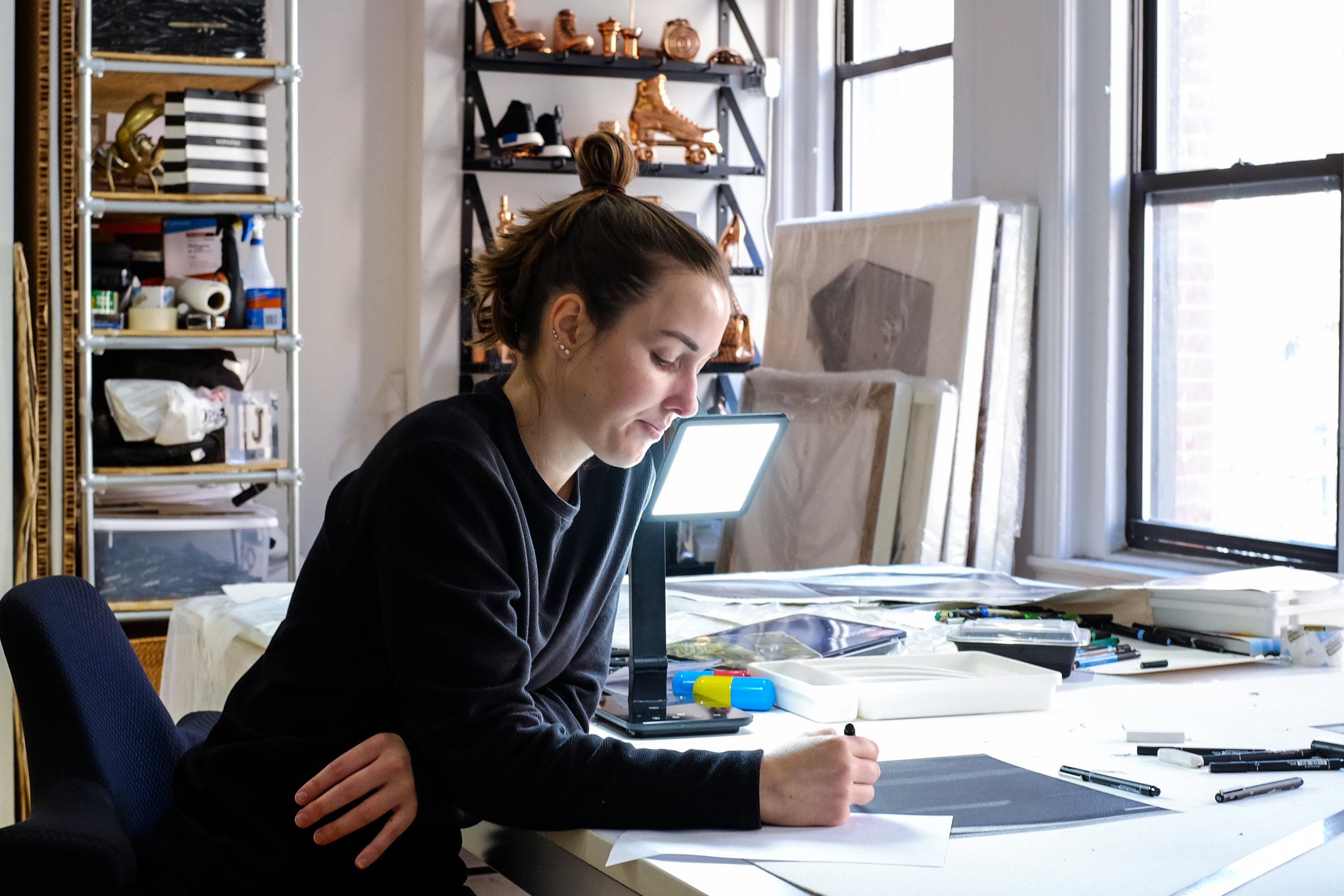
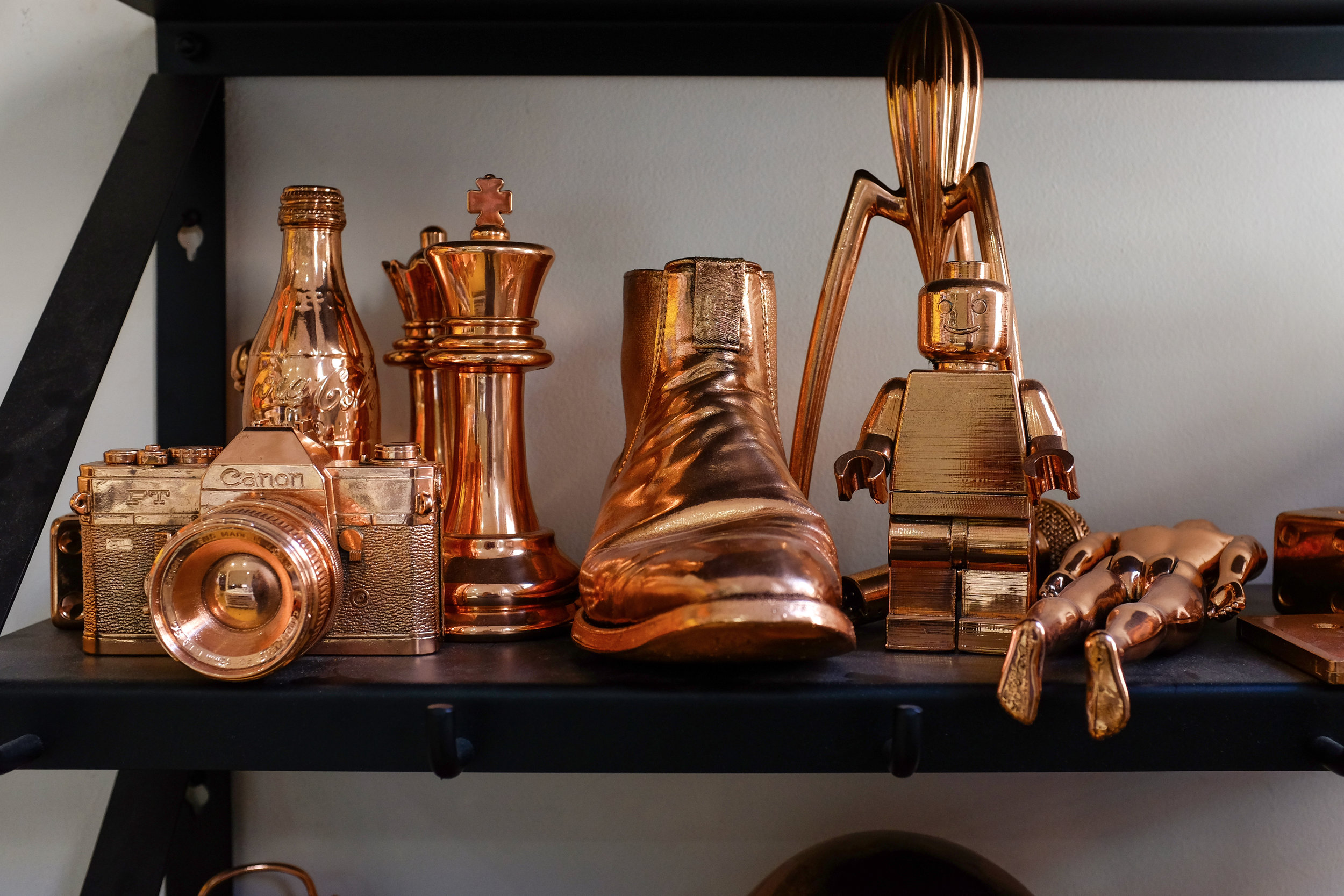
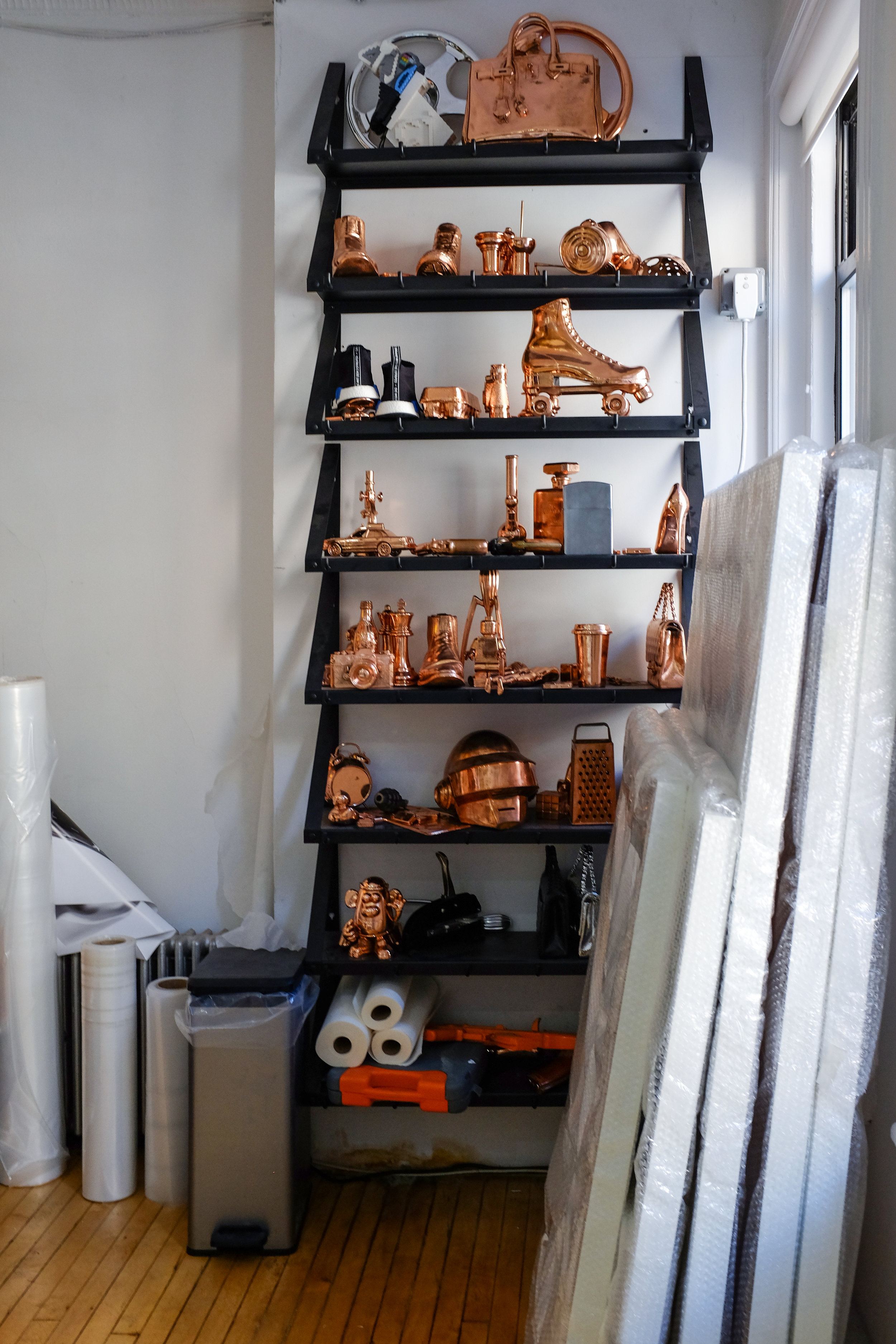
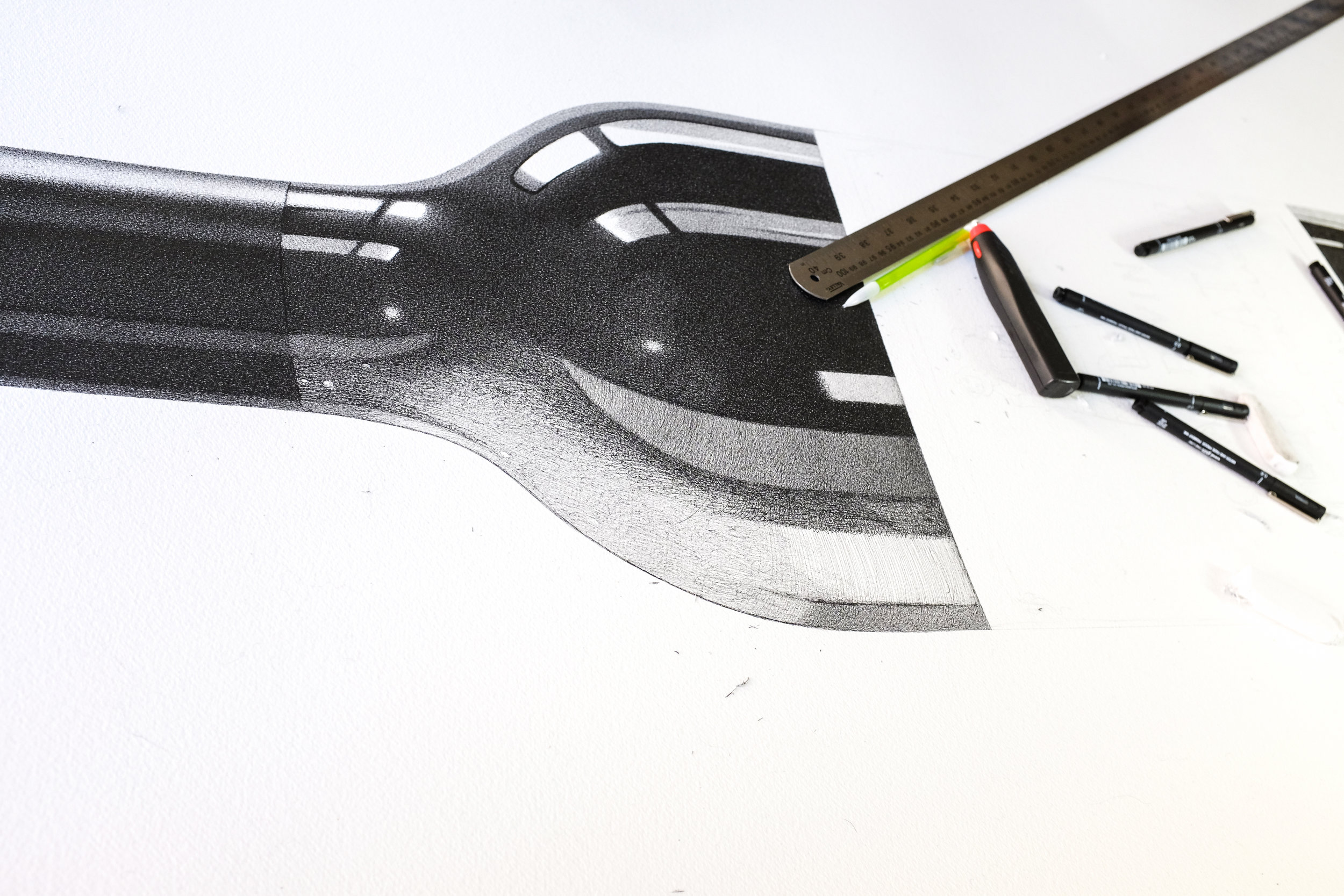
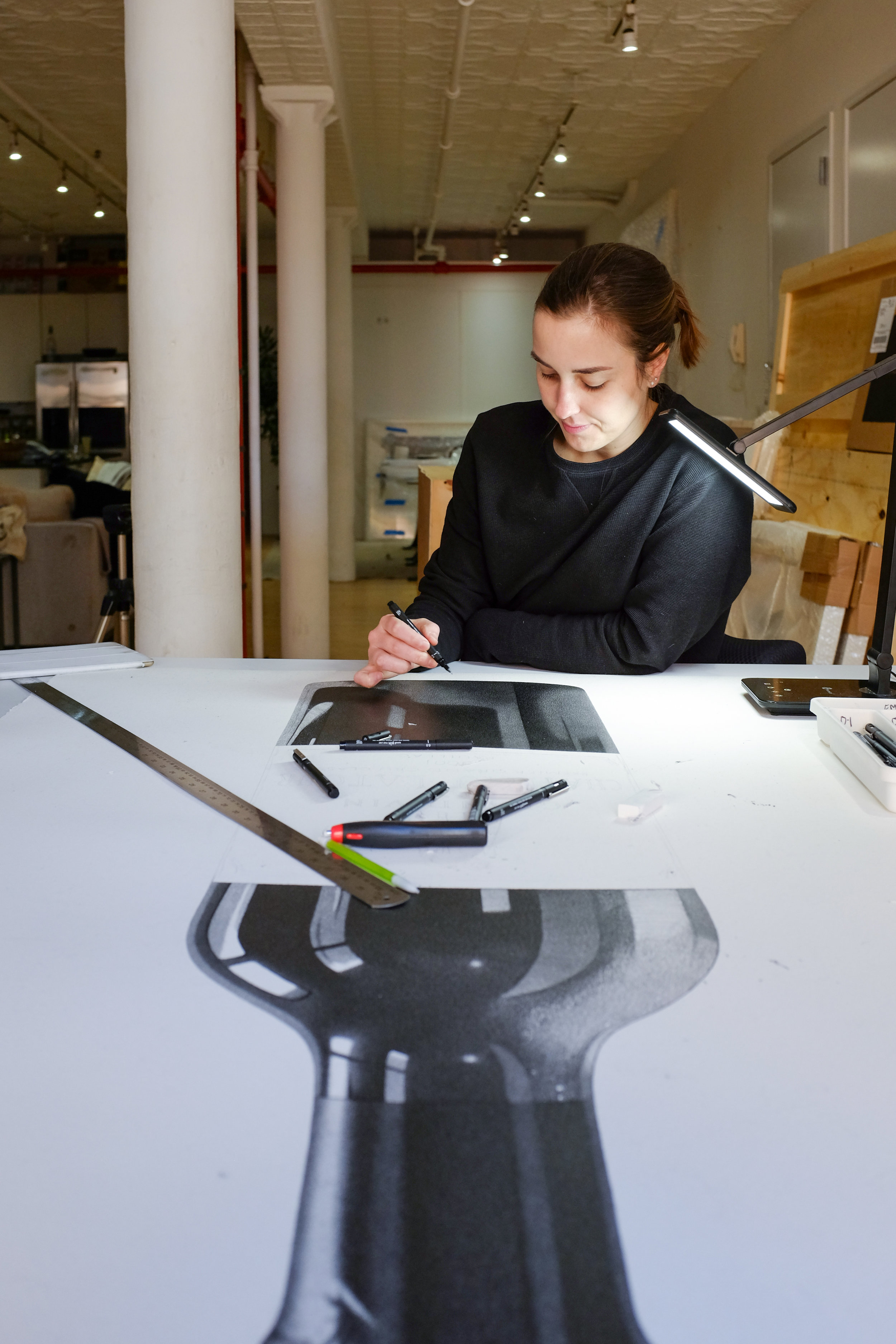
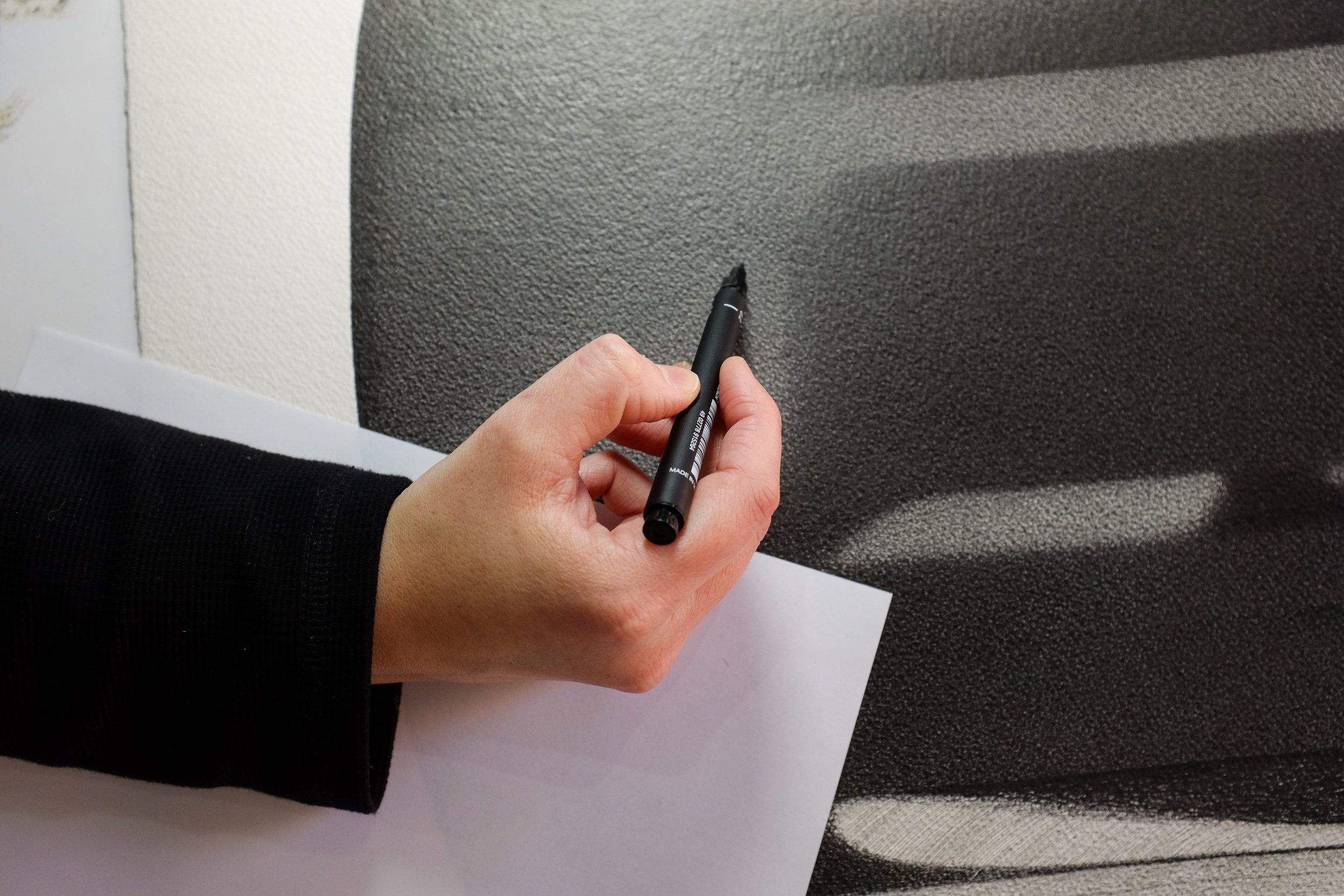
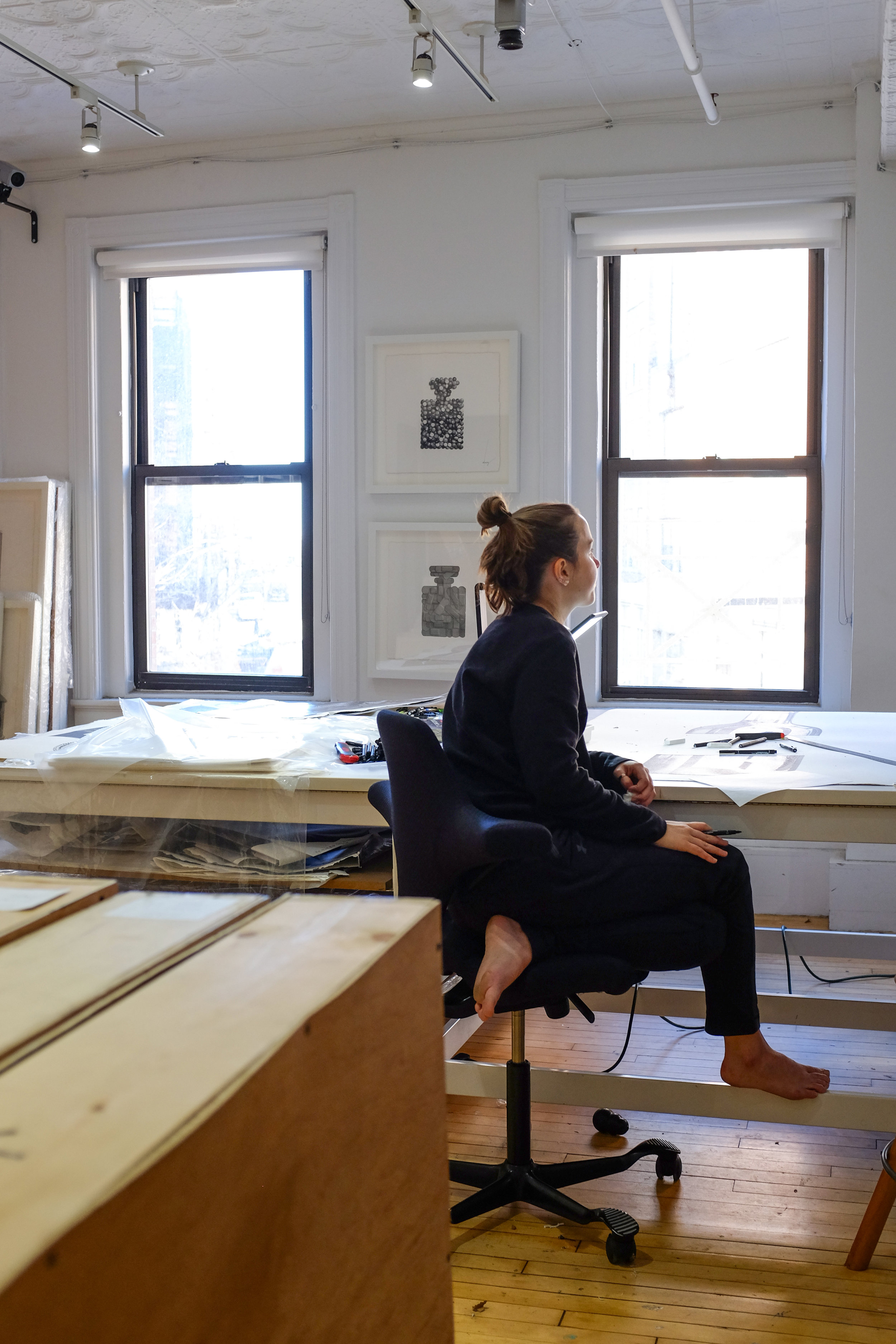
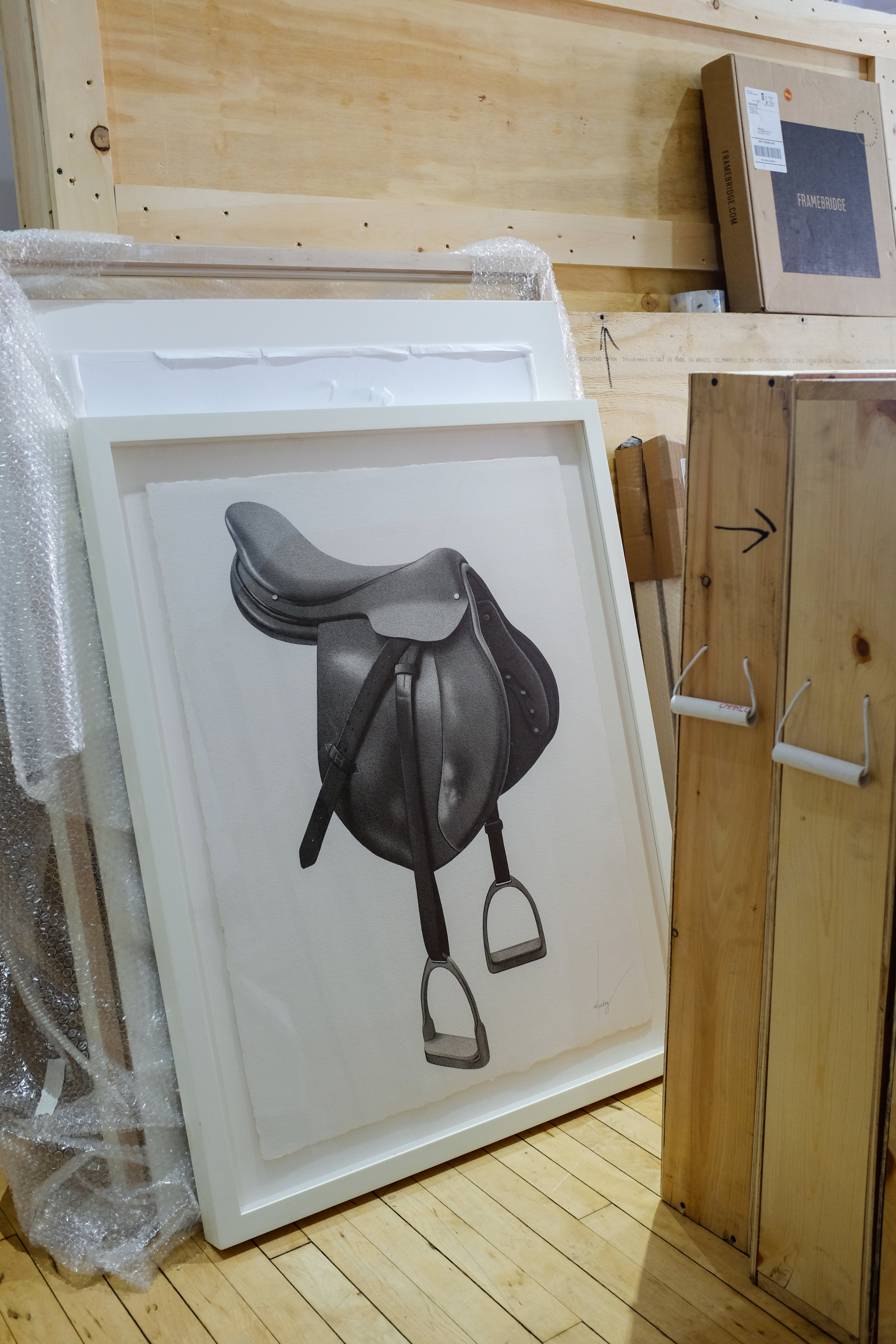

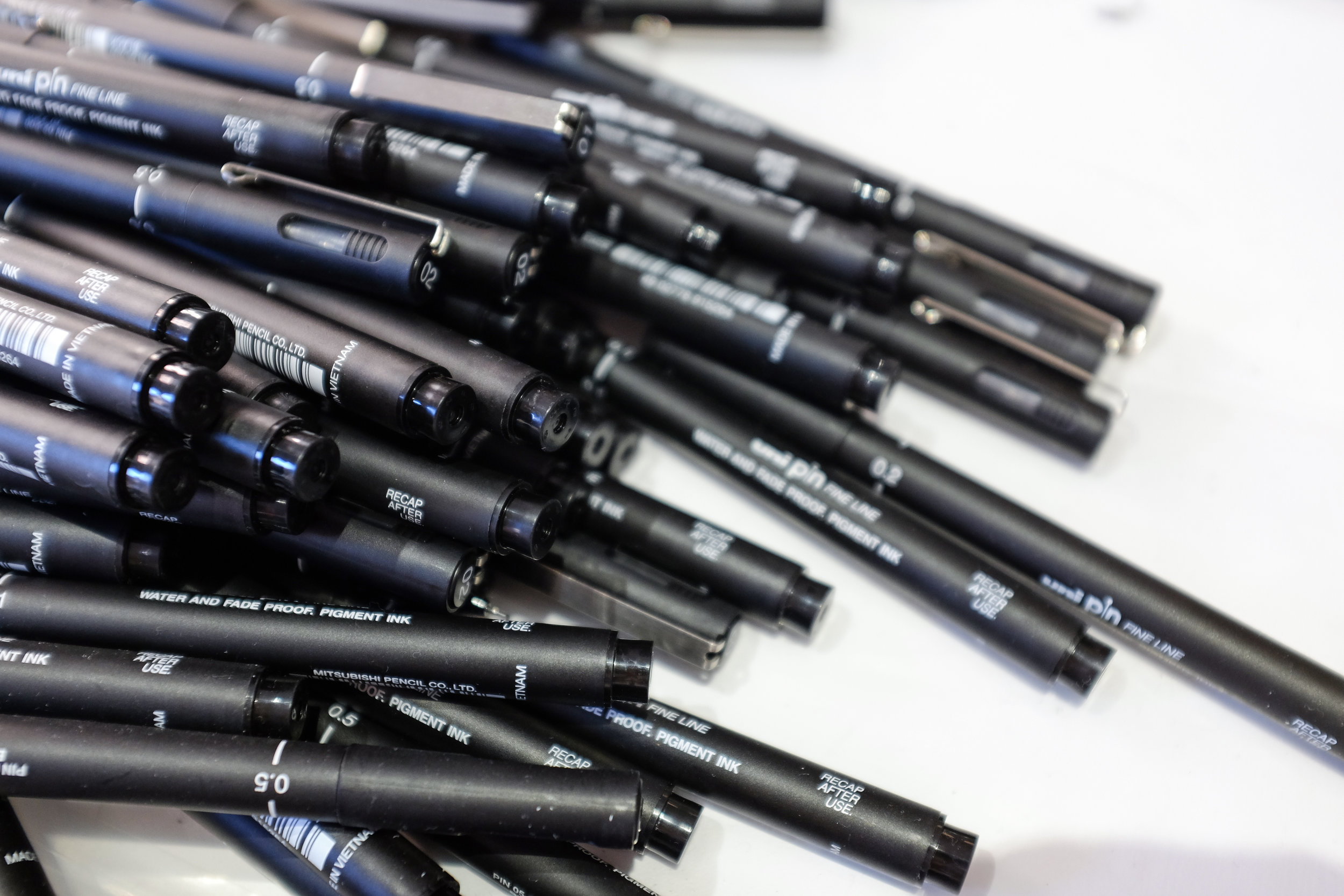
CJ Hendry
Who are you?
My name is CJ, I am an artist. I draw - only with pen and paper thus far. I’m sure that my medium will grow and develop and change, but at the moment all I’ve done is pen and paper. I’ve become very comfortable with it and I know it like the back of my hand. I’m an expert with pens and paper. I draw in a hyper-realistic style, I should probably note that. My drawings usually look like the photographs I reference, I hope.
What are the primary subjects of your work?
Product. It has always been product. I’ve never done portraits or landscapes or anything. I’m not saying that it doesn’t interest me, it’s just not my top priority at this stage. I’m not going to say that I’m never going to do it.
You know when you first start drawing and you’ll draw an eye or a hand or a person’s face? It’s just the obvious choice; I remember drawing that when I was 12 years old. But I like to do different things and things that are completely true to myself, so I started drawing a lot of product because that’s what I loved and was obsessed with. In recent times product and spending money on stuff is becoming less and less a priority; it’s just not my first ambition anymore. So hopefully as time progresses you’ll see a movement towards subjects that are a little bit more conceptual, because that’s just where I’m at. I’m not so fazed by stuff. But obviously, with commissions, product is what people know my work for. So I am still doing it, but I also want to try different things and move in other directions.
What role does the pedestal play in your work?
I kind of took the pedestal idea to the extreme with The Trophy Room, a show that recently finished. All of the objects are iconic objects, some of them are high end and some of them, like the Zippo lighter, are not. I put them each on a trophy stand, and they were shiny and they sat atop something. That was probably the most conceptual work I have ever done. These objects are all so different and yet each special in it’s own way. For one person it might be the bag while for another person it might be the steering wheel or the cheese grater. Potato Head is still my all time fave. It’s different for everyone.
But in general, I put product on a pedestal and I totally respect it. Even when a literal pedestal isn’t present, there is so much negative space in my work and it is intentionally symmetrical. I’m not that artist that will do a little something something on the side, that freaks me out. Also, the frame is white, the backing board is white, and we spend a ton of time matching the shades of white, so that all you see is the black of the pen. It becomes this super pop thing. The object is your focus.
How do you navigate issues of copyright?
I actually haven’t dealt with issues of copyright; I have always been very cautious of that because I know I’m referencing product. I have heard of other artists who have drawn or painted in photorealistic styles and had copyright issues because they just took their reference material off the internet. I’m not saying it will come back to bite you, but I’m at a stage now where people would know if something wasn’t my image. I really just don’t find that authentic, it’s not high resolution and it’s not your idea. You haven’t created the thing, you’ve just gone in and drawn it. So I go to the ends of the Earth to get the things I need. I’ll destroy it, I’ll dip it - I’ll do anything just to get the image I want and to tell my story.
The best way to explain copyright is this. Say Chanel did a quilted handbag and say we were to come along and design a handbag called CJ’s bag that looked exactly like that Chanel motherfucker. That’s copyright infringement because we’d be selling a bag that looks exactly like the Chanel.
I’m not doing that. I am selling two-dimensional pieces of art. There are a lot of artists who reference product and brands. It’s been done for years and will continue to be done for years. Some do it in a really tacky way, others do it in a totally different way. Everyone just does it in their own way. Like Richard Price - do you remember when he took photos from Instagram and printed them out on canvases? Obviously people are going to say a few words, but there are definitely not copyright problems. Think about Andy Warhol’s Chanel bottle.
How have you learned what you know?
I was brought up in a middle class family. Mom and dad worked really hard to send my sister and I to a private girl’s school in Australia. After I left high school I went and studied architecture for a couple of years. I was good at it but I didn’t love it. I thought I would like it more - I thought it was more creative - but it was a bit too in the office for me. Then I went and studied finance and accounting for many years. I enjoyed it and found it interesting but I wasn’t good at it. Still, if I wasn’t an artist, I would be in private wealth or doing something in business. That sounds really lame, doesn’t it? That’s just my brain; I am super logical.
While I was at university I got a job working in retail at Chanel for a couple of years and that actually taught me a lot. I was obsessed with luxury, so I was buying luxury well before I could afford it. Then this job was interesting because I started to understand branding. There are so many different brands that are iconic for their own reasons, and by working at Chanel I began to see that more and more. People walk in and fucking lose their minds over a handbag. It is so interesting that it has become this icon. It was the easiest job, you didn’t need to a thing to sell. You just hold up the handbag, say there’s only one and they’re like, boom, done, we’ll take it. Drop the tenner. The brand sells itself.
In my work now I’m at a stage where I have a brand that sells itself. People know the quality and know that it’s one of a kind. They know the story.
Did you have any teachers or mentors who helped shape you as an artist?
So this is very unusual to say, but I don't have art mentors or any mentors in a creative sphere. A lot of my mates are mentors in that they're doing something that's real, like building apps or running businesses. I find the art world so behind and I can't look there because it'll just frustrate the hell out of me. I don't have a lot of artist friends because I find it so frustrating to talk art and bullshit. It’s like we don’t need to have this whole discussion, just make cool shit. So I'm inspired by a lot of our mates who are doing really cool things outside of the art world.
I also don’t have any fine arts training or art history background. I’ve been drawing ever since I came out of the womb, and I’ve always been very good at it. I just had a knack for it, but only in the last four years has it actually become a thing.
What drew you to pen?
My OCD, which I just think I have- it’s self diagnosed. I am very particular. Pencil always bothered me a little because it would smudge and things that didn’t need to be on this crisp white paper were always there. That just grinded my gears. I admire artists that can work with pencil, but it just doesn’t work for me. I was introduced to these pens through my architecture years. Pen is the most clinical because you cannot rub it out and it stays there. You can lighten it a little bit, but once it’s on the paper it’s done and I love that. It is so permanent, it is finished. Not that I am saying that pencil or charcoal isn’t finished. There’s just something about having to sharpen a pencil that I don’t like. And paint freaks me out.
What are the freedoms and limitations of working only in black pen?
When you are working in black and white, the only freedom you’ve got is the subject matter. I think that what’s so exciting about this new secret series that I am working on is that it is bringing in a whole new dimension to the work. Yes, it's still two-dimensional and it's still hyper realistic drawing, but there are more possibilities now. I don't know what will come after that.
A lot of people will have a five year plan. How can you do that? How do you know where you're going to be in five years? I could be dead. My work is authentic to the core because I don't plan this stupid strategical thing like this or like that. I'll find something and I'm like great, boom, I'll draw that now. I couldn’t tell you what I’ll be doing after March. Honestly no idea. I don't know what dealer I'll be with or what gallery I'll be with or what subject matter I’ll be drawing - I have no idea.
Under what conditions do you work best?
I could work with anything. I generally have my headphones on and I'm listening to podcasts and audiobooks. Or I’ll have my iPad to the side and I’ll watch Netflix in my peripheral vision. I have these Bose noise-cancelling headphones. When you put them on you really don’t hear anything; it’s like you’re in a little bubble so you can focus in on drawing. I think that helps a little. But there's never an ideal.
Do you have any rituals surrounding your practice?
No. I'm not that kind of artist. My process is very labor intensive; it's a lot of time spent making my art. So I kind of work around that. I wake up, now I'm starting to exercise, and then I'll draw all day. I might draw on average fifteen hours a day. I don't stop too much, unless there's a meeting-type thing.
Describe your process.
I think my process is relatively logical. So I think of how I want to showcase the object I've chosen. I go about acquiring the object, borrowing it or however, and then I'll photograph it like a hundred times in different ways. I don’t have a full-on lighting set-up, so it'll just be natural light. Then I'll go through the photos. I don't know how to use Photoshop so I just like flick through and I'm like oh that photo's cute. Boom. Then I just throw it onto the projector and trace it with pencil. The tracing in pencil is still quite amateur. The lines just establishes the general gist of where things are so that I've got the proportions. From there it's just a matter of drawing methodically. It'll take maybe three or four layers depending on what shade I have to get. So there's not that much creativity; it's a very structured way of going about doing things.
Have you ever drawn the same thing twice?
I don’t often entertain the idea because I don’t have the energy to draw things twice, but if someone is dying for it, we can talk about it. I’ve done snakeskin boxing gloves twice, but layed them out completely differently each time.
What role does social media play in your process?
When I first started out, I just started posting things on Instagram with no intent of anything. I mean maybe there was a background intent that hopefully something would happen, but you can never really plan that shit. So I kind of just went for it. I eventually ended up talking to a guy who owns a blog called The Cool Hunter, where he sells knick knacks online. We came together and decided to showcase my art and do shows in the most unconventional ways. For example, we did this enormous show in this home that we converted into a warehouse; we stripped the space and put art on every single wall. We had this extravagant opening night, it was fun. People came and were blown away. We did something similar in Melbourne and then in New York.
I just want people to love and feel comfortable around art, instead of having the constant, awkward feeling of Should I even be here? It’s quiet and uncomfortable and very art world. Personally I fully understand that world, but in general I’m just trying to make art more accessible. My artwork isn’t fully accessible in terms of the price point and availability, but I want it to be accessible for people in terms of looking at it and vibing with it. Coming from a commercial marketing brain, this seems simple to me.
The art world is so behind. People have got to get with it. It’s all happening on the social media side. I get criticized a lot for using social media but the reality is that a lot of galleries are not very profitable. They continue to work a model that did work at one point but is now just outdated and unprofitable. I don’t know why. It’s the weirdest thing. That’s probably something that you won’t hear about in art school. I don’t think there ever will be a business class in art school, only because the artist is not meant to understand that side of things; that’s up to the dealer and gallery. They get paid for that privilege. As an artist you are just meant to create. The gallery is meant to do the business. The dealers and galleries really hate the Instagram movement because buyers can go straight to artists, which is a problem. Why go to a gallery if you can interact with the artist directly? I find this whole business side of art very very interesting.
In what ways to commissions and commodification play roles in your work?
I run a business, which is hard because I think that it’s really important to also stay true to yourself and do what you want. So I don’t take on many commissions; I am very selective with them. Commissions start at a certain size, so not just anyone can come in and get a commission. This piece I’m working on now is for an old family friend of our’s who is just lovely. She has supported me throughout my career, so obviously I’m going to bend for this particular woman. If the subject matter is really fun or if the commission is for a particular brand that makes sense I’ll consider it, but I don’t just do whatever. Even with most of my shows, like The Trophy Room, no one really has any say in the work but me. I just go in, do my thing, and then put the work out to the public and say this is the size, this is the price - ready, go.
In what ways has your practice evolved over time?
I don't actually think that the process has evolved; I think my thoughts and the subject matter and the way I want my work to be perceived has evolved. From drawing just a pair of sneakers or a bag or a top to making The Trophy Room, my work is going in a more conceptual direction. I don't think that the process changes, it still has to be done a certain way, but I think that moving to different subject matter is where things have to change.
Is there anyone or anything that inspires you?
There are so many things. In terms of the hyper-realistic space and scale, maybe Robert Longo - he's the baddest bitch. There’s a British guy, not as well known, named Jonathan Delafield Cook whose work is really eerie and beautiful. There are so many that I can appreciate for different reasons. But in general I mostly admire these artists who are doing things that are interactive or related to scale or are just inspiringly mind blowing. Artists like Yayoi Kusama. Her Obliteration Room is an all-time favorite of mine. She nailed it! Bravo.
What's the most challenging part of your process? Where do you find the most ease?
The easiest part is drawing it. And I don't find that conceptualizing and getting the object and doing it the way that I want is hard. The hardest part is showcasing the work. I've been wanting to get more into shows that are way more experiential, where the viewer gets to interact, touch, feel, do shit. It’s the little things like doing a show that let other people see the work in the flesh, and feel it’s presence. I don’t have to do a show; for the last one everything was sold before we went in. But I want to give people a chance to be a part of the work. I want people to come in and get to create something. There's something really special for me about that for me because I don't come from the art world, so I'm kind of putting myself back where I started, with everyone else. I'm just like I am you! Come to do what I do! So you know it's an interesting thing, I'm very excited for it.
What's the best piece of advice you've ever received?
I don't know. I think if I was to give myself advice I would say just do you. I think that so often you’re encouraged by your parents to do this, that, and the next thing, but quite often at some point - sometimes much later, sometimes too late - you come back to what you truly love and what you're truly good. You figure it out eventually. But if it’s too late, sometimes you can't end up doing it. So start to understand what you actually are, like if you're just a general weirdo, like I am. I'm weird and I do weird things and I'm so proud of it now, but back when I was a lot younger I would try and be more normal and fit in with everyone. Really I'm just a loner, I love being on my own, and I'm so comfortable with that now. It has allowed me to do what I do on an extraordinary scale. So be yourself now because you will end up being yourself eventually. Really just internalize and bring to the surface the things that you love to do and are good at. Embrace your weirdo.
What has your practice taught you?
I think that I'm now beginning to understand patience a little bit more. I'm very hungry, I'm very ambitious and I expect too much too soon. But nothing of value comes quickly. Things can happen quickly, yes, and unexpectedly, but true brilliance does take a bit of time and that's something I'm very much coming to appreciate. None of the big dogs just winged it. There's a certain level of weeding out that has to happen, so you’ve just got to do extraordinary things to earn your place and to earn that kind of respect.
There are plenty of artists doing what I do now, which I think is actually really awesome. I think that at the beginning I used to get really frustrated by that. Now I think that if people like drawing as much as I do, they should go for it. I'm so grateful to do this every day. If they want to copy me exactly, go for it.
How has your practice shaped your hands?
My hand is insured. That's so weird, I know. It's insured and my hand is just really fit. I draw every day and I literally never have problems, it's never sore. But one hand is definitely bigger and stronger than the other. I can draw a perfect straight line. If I was to be a doctor or a surgeon, I'd do the most extraordinary surgery. It would be amazing. Maybe I'll be a doctor later.
CJ Hendry in New York, New York on January 4, 2017. Photographs by Julia Girardoni.
